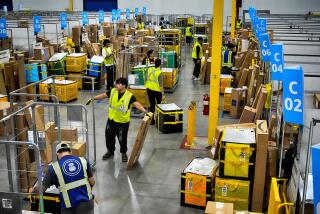Wages, Spending Both Gain O.3% : Economy Slower but Not Recession Bound, Analysts Say
WASHINGTON — Americans’ incomes rose 0.3% in January, a moderate increase that matched the gain in consumer spending during the month, the government reported Friday.
The Commerce Department said that incomes and spending both rose 0.3%, following identical 0.7% advances in both categories during December.
The gains were taken as positive signs that consumer spending, while not growing as briskly as it did during the early years of the economic recovery, will at least expand enough this year to keep the economy out of a recession.
Consumer spending, which accounts for two-thirds of overall economic activity, is being closely monitored following the October stock market collapse.
“These figures support our impression that the economy will slow down this year but continue to move ahead,” said Roger Brinner, an economist with Data Resources Inc. of Lexington, Mass.
Spending Cautiously
Consumer spending, after adjusting for inflation, fell at an annual rate of 3.1% in the fourth quarter, the biggest decline in more than seven years. Brinner predicted that much of this decline would be reversed in the current January-March quarter, in part, because auto sales have rebounded.
Wages and salaries, the key component of the income category, increased $12.4 billion in January, more than double the $5.6-billion December increase. This gain included a $2-billion increase in payrolls at manufacturing companies, which followed a $1.1-billion December increase.
Allen Sinai, chief economist for Boston Co., said the rise in incomes, while below previous months, was still strong enough to support further increases in spending. He noted that incomes in manufacturing have risen 4.7% in the past 12 months, compared to growth of just 1.8% in the previous 12 months.
“We have a picture of a consumer with adequate income growth who has become a bit more cautious and is more likely to save, but is not going to stop spending and drive the economy into a recession,” Sinai said.
Americans’ savings rate, savings as a percent of disposable income, rose to 4.7% in January, 0.3 percentage point higher than the December level.
The 0.3% increase in spending reflected an annual rate of increase of $10 billion, with almost all of the strength coming in the services category.
Purchases of durable goods, items expected to last three or more years, edged up $200 million, compared to a $12.3-billion December advance. Purchases of non-durable goods fell $700 million, in contrast with an increase of $5.3 billion in December.
The services category, which includes housing expenses, shot up at an annual rate of $10.6 billion in January, much faster than the $4.2-billion December rise. Some analysts said this reflected in large part a big jump in inflation in the services sector during the month.
In a separate report Friday, the Labor Department said medical care services rose 0.8%, the steepest increase in two years, while rental costs and other service charges also posted big gains.
In January and December, personal income was affected by a variety of special factors, including pay raises for federal employees, cost-of-living adjustments for Social Security recipients and swings in farm subsidy payments.
Farm incomes fell $10.5 billion in January, erasing a $10.4-billion December increase. Excluding the big swings in government subsidies, farm incomes would have increased $500 million in January following a $1.5-billion December decline.
After-tax incomes rose 0.6% in January following a 0.7% December increase.
More to Read
Inside the business of entertainment
The Wide Shot brings you news, analysis and insights on everything from streaming wars to production — and what it all means for the future.
You may occasionally receive promotional content from the Los Angeles Times.










